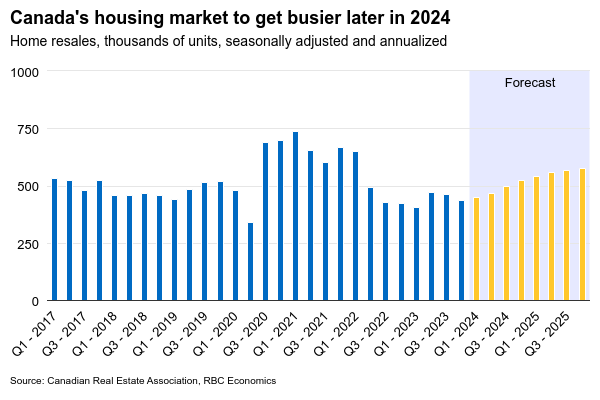The Canadian real estate market is on the brink of an intriguing journey in 2024, as RBC Economics reveals its latest insights into the nation’s housing sector. The largest bank in Canada anticipates that the dynamics of interest rates will be the key driver of the real estate market’s performance, leading to a slow start in the first half of the year but holding the promise of a resurgence later on.
A Cautious Beginning for Canadian Real Estate Markets in 2024
The outlook for the Canadian residential real estate sector suggests a modest start during the first half of the year. Despite some easing in fixed-rate mortgage financing, the persistently high housing prices, combined with elevated interest rates, are likely to weigh on the market’s early performance. Robert Hogue, RBC’s assistant chief economist, explains, “We foresee sluggish activity and a gradual softening of prices in the initial months of the year as the Bank of Canada maintains its high policy rate.”
Hogue goes on to note, “The course of Canada’s housing market in 2024 will be largely influenced by interest rates. However, the expected shift towards rate cuts in the middle of the year may revitalize the market during the latter half or even sooner.”
With the spring season historically being the busiest period for real estate, the initial slowdown may create downward pressure on prices due to accumulating inventory. Nonetheless, the consensus among economists points toward imminent rate reductions, which could mitigate this effect.

Anticipated Rate Cuts to Boost Home Sales in Canada
RBC’s forecast aligns with the broader consensus among Canadian economists, as it anticipates lower interest rates by mid-year. This, coupled with factors like rapid population growth, stronger wage growth than initially anticipated, and pent-up demand, offers a glimmer of hope for increased market activity in the second half, especially in terms of sales.
The bank’s projections envision existing home sales reaching 484,000 units in 2024, marking a 9.2% increase from the previous year. While sales volumes are poised for further growth in the following year, they are unlikely to reach the unprecedented levels witnessed during the height of the pandemic.
Canada May Experience Heightened Sales, Yet Lower Prices Projected
It’s crucial to recognize that an improved market does not necessarily equate to a market frenzy, a point that RBC is keen to underscore. While home sales are poised to ascend, the concurrent increase in inventory levels and stretched affordability are expected to exert downward pressure on prices.
Robert Hogue highlights this by stating, “The prospects of improved sales activity are likely to entice more sellers into the market,” as higher sales volumes often prompt homeowners to list their properties. However, the influx of inventory may not solely result from homeowners, as investors seeking to exit the market, particularly given reduced profitability in long-term rentals due to financing costs, could add to the supply.
Hogue also observes, “Mortgage renewal payment adjustments could further stimulate property owners to list their properties. A surge in sellers would help maintain a balanced supply-demand equilibrium, thus preventing any excessive upward pressure on demand.”
The ongoing challenge of housing affordability is unlikely to see immediate relief, with wage growth expected to remain subdued even after interest rate cuts, as these cuts tend to accompany economic downturns. As a result, despite pent-up demand, poor affordability conditions are projected to initially hinder the market’s recovery.
According to RBC’s forecast, housing prices are expected to experience a marginal 1-point decline this year, followed by a more substantial 3-point increase next year, aligning more closely with inflation rates. The anticipated continuation of declining interest rates into the following year is poised to offset this modest price increase, further reinforcing their sales forecast.
In summary, while the Canadian real estate market may confront initial challenges in 2024, the potential resurgence in the second half, driven by declining interest rates and various contributing factors, could result in increased sales activity, despite expectations of modest price adjustments.





